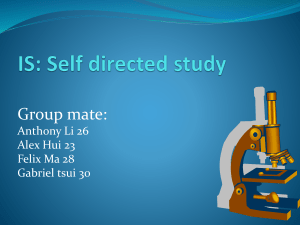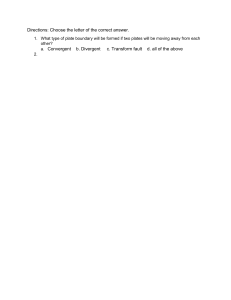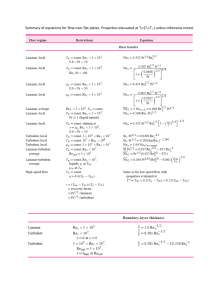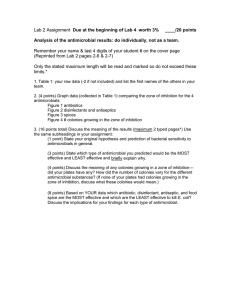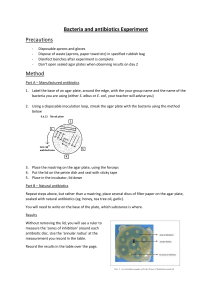Microbial Growth Inhibition: Alcohol vs. Penicillin Lab Report
advertisement
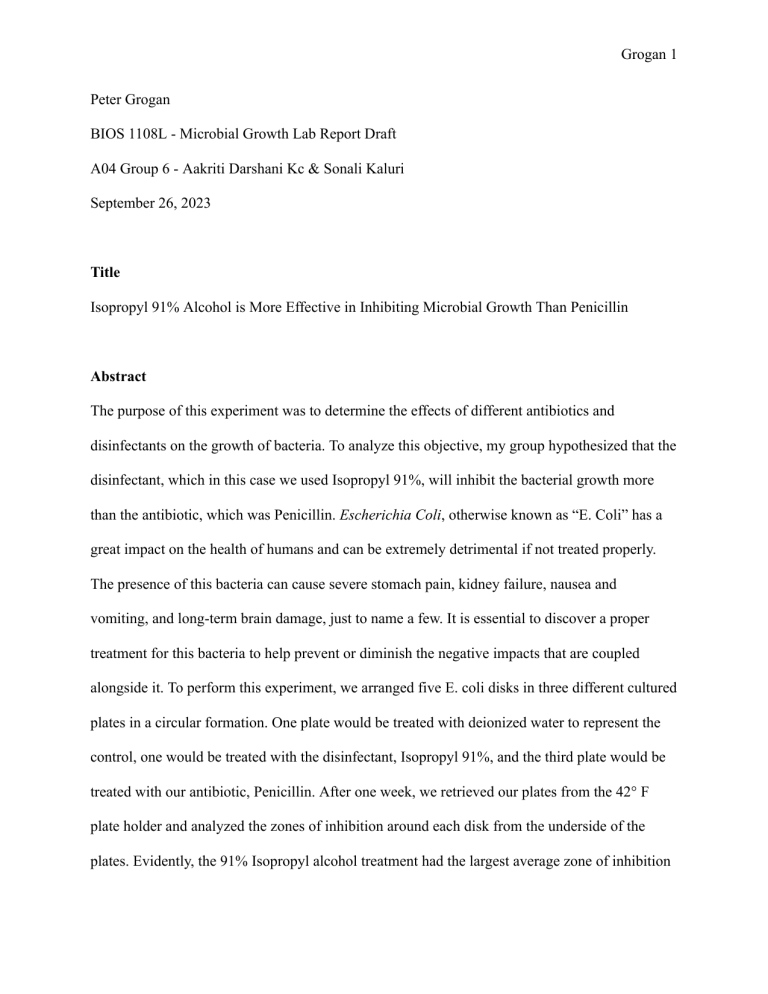
Grogan 1 Peter Grogan BIOS 1108L - Microbial Growth Lab Report Draft A04 Group 6 - Aakriti Darshani Kc & Sonali Kaluri September 26, 2023 Title Isopropyl 91% Alcohol is More Effective in Inhibiting Microbial Growth Than Penicillin Abstract The purpose of this experiment was to determine the effects of different antibiotics and disinfectants on the growth of bacteria. To analyze this objective, my group hypothesized that the disinfectant, which in this case we used Isopropyl 91%, will inhibit the bacterial growth more than the antibiotic, which was Penicillin. Escherichia Coli, otherwise known as “E. Coli” has a great impact on the health of humans and can be extremely detrimental if not treated properly. The presence of this bacteria can cause severe stomach pain, kidney failure, nausea and vomiting, and long-term brain damage, just to name a few. It is essential to discover a proper treatment for this bacteria to help prevent or diminish the negative impacts that are coupled alongside it. To perform this experiment, we arranged five E. coli disks in three different cultured plates in a circular formation. One plate would be treated with deionized water to represent the control, one would be treated with the disinfectant, Isopropyl 91%, and the third plate would be treated with our antibiotic, Penicillin. After one week, we retrieved our plates from the 42° F plate holder and analyzed the zones of inhibition around each disk from the underside of the plates. Evidently, the 91% Isopropyl alcohol treatment had the largest average zone of inhibition Grogan 2 around the disks in the E. coli culture (7.3 mm), followed by the penicillin treatment (4.8 mm), and the control group (dishes of distilled water) had the smallest average zone of inhibition (0.0 mm). We measured each zone’s radii to determine its growth using calipers. Our findings yielded a p-value of 0.231 which is greater than the level of significance of 0.05, so we failed to reject our null hypothesis. These results are very valuable as they may recommend a more effective way to treat microbial growth on a broader scale, and can aid in the discovery of the best form of treatment. Methods The purpose of this experiment was to determine which form of treatment would be a better option to inhibit the growth of E. coli. The testing was designed to mimic a naturally occurring environment and develop data that would accurately represent the same relationships if it were to occur in nature rather than a lab. Initially, we used three different plates to complete this experiment. In each plate, we equally placed five E. coli cultured disks in a circular formation. Using a micropipette, one plate was treated with deionized water and would act as our control stimuli, one was treated with our chosen antibiotic, Penicillin, and the third one was treated with our chosen disinfectant, which was 91% Isopropyl Alcohol. We then placed the plates in a 42° F plate holder and gave them a week for growth. When it came time to analyze our results and record the data, we were sure to be very tedious with our measurements as we were working with miniscule subjects. After the week of growth, we used calipers to measure the growth of the inhibition zones, using millimeters as our unit of measurement. To record it, we flipped the plates over with the lids remaining on, and the radii of each zone was carefully measured, which consisted of the growth from the very middle of a disk to the very outer edge of its inhibition Grogan 3 zone. We would then record each of the five disk’s zones of inhibition growth for all three plates in a table, which is represented by Table 1 below. The greater the radius, the greater the zone of inhibition. Once recordation is complete, the average growth in millimeters per plate would be calculated and the plate with the highest average length of inhibition zone radius would be concluded to be the most successful in hindering microbial growth. Using our data from the experiment we decided to conduct a one-sided ANOVA test to calculate our significance. The p-value that we calculated was 0.231, which is greater than 0.05 (the level of significance). Since our p-value was greater than the significance value, we can conclude that our data fails to reject the null hypothesis. Results According to the findings of our experiment, the 91% Isopropyl Alcohol treatment had the greatest average zone of inhibition around the disks with a length of 7.3 mm. The Penicillin treated plates had the second-largest average zone of inhibition around the disks in the E. coli culture, with an average of 4.8 mm, followed by the control group (dishes of distilled water), which had the smallest average zone of inhibition (0.0 mm). Additionally, it was determined that the most effective method for stopping the development of E. coli appeared to be the 91% Isopropyl Alcohol (disinfectant) treatment. These findings help determine the differences between the effectiveness of disinfectant and antibiotic on bacterial growth. A p-value of 0.231 was calculated using the results of our experiment. This value is well over the alpha value, which leads to the claim that our results are not statistically significant. Grogan 4 Discussion We were able to reject the null hypothesis as a consequence of the experiment's overall findings, which also supported the alternative hypothesis we had proposed before to the trial. The findings support our initial hypothesis that the disinfectant, Isopropyl 91%, will inhibit bacterial growth more effectively than the antibiotic, Penicillin. The disinfectant functions by rupturing membranes, which causes cell lysis, and quickly denaturing proteins, which hinders cell metabolism. As a result of the damage to proteins in the bacterial cell's outer layers, the entire cell splits open and dies. These findings mean that the functions of the disinfectant are more properly suited to inhibit bacterial growth, as the antibiotics work by breaking down the cell walls and interrupting vital cell processes needed for survival. In this case, the functions of the disinfectant were more sufficient. We expected to see zones of inhibitions around the disks in both the treated plates, which we did. However, the size of each zone is what was being experimented and the growth of each zone would help determine which treatment was more effective. To support our hypothesis, we would need evidence that portrayed larger zones of inhibition around the disks treated with the disinfectant when compared to those of the disks treated with the antibiotic. This is analytically true because the average length of inhibition zone around the disks treated with 91% Alcohol was 7.3 millimeters, whereas the average length of inhibition zone around the disks treated with Penicillin was only 4.8 millimeters. To ensure that no single outlier data point has a significant impact on the results, a larger sample size may be used if repeating this experiment. Also, a more uniform application of the isopropyl and DI water via the micropipette is another aspect of the operations that should seek improvement. Although the compounds were placed on the disks for their group in a manner that was very comparable and analogous, some discrepancies may be present regarding the amount of treatment each group Grogan 5 received. These changes may result in the experiment’s data to become much more accurate and reliable. Figures Table 1. Zone of Inhibition Size Radii (in mm) Around Untreated and Treated Disks on Plates of E. Coli. Disk # Control (mm) Penicillin (mm) 91% Isopropyl Alcohol (mm) 1 0.0 3.0 2.7 2 0.0 4.0 5.0 3 0.0 4.9 6.5 4 0.0 6.7 9.1 5 0.0 5.5 13.4 Avg. 0.0 4.8 7.3 p-Value: 0.231 Figure 1. Visual Bar Graph Display of Table 1 Grogan 6 Honor Statement Having read the Georgia Institute of Technology Academic Honor Code, I understand and accept my responsibility as a member of the Georgia Tech community to uphold the Academic Honor Code at all times. In addition, I understand my options for reporting honor violations as detailed in the code. X Peter Grogan
